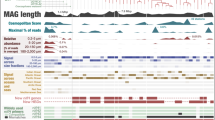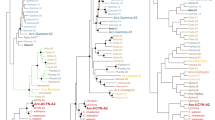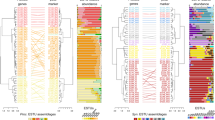Abstract
Nitrogen (N2)-fixing marine cyanobacteria are an important source of fixed inorganic nitrogen that supports oceanic primary productivity and carbon dioxide removal from the atmosphere1. A globally distributed2,3, periodically abundant4 N2-fixing5 marine cyanobacterium, UCYN-A, was recently found to lack the oxygen-producing photosystem II complex6 of the photosynthetic apparatus, indicating a novel metabolism, but remains uncultivated. Here we show, from metabolic reconstructions inferred from the assembly of the complete UCYN-A genome using massively parallel pyrosequencing of paired-end reads, that UCYN-A has a photofermentative metabolism and is dependent on other organisms for essential compounds. We found that UCYN-A lacks a number of major metabolic pathways including the tricarboxylic acid cycle, but retains sufficient electron transport capacity to generate energy and reducing power from light. Unexpectedly, UCYN-A has a reduced genome (1.44 megabases) that is structurally similar to many chloroplasts and some bacteria, in that it contains inverted repeats of ribosomal RNA operons7. The lack of biosynthetic pathways for several amino acids and purines suggests that this organism depends on other organisms, either in close association or in symbiosis, for critical nutrients. However, size fractionation experiments using natural populations have so far not provided evidence of a symbiotic association with another microorganism. The UCYN-A cyanobacterium is a paradox in evolution and adaptation to the marine environment, and is an example of the tight metabolic coupling between microorganisms in oligotrophic oceanic microbial communities.
This is a preview of subscription content, access via your institution
Access options
Subscribe to this journal
Receive 51 print issues and online access
$199.00 per year
only $3.90 per issue
Buy this article
- Purchase on Springer Link
- Instant access to full article PDF
Prices may be subject to local taxes which are calculated during checkout




Similar content being viewed by others
Accession codes
Data deposits
The UCYN-A genome reported here has been deposited at GenBank under accession code CP001842.
Change history
04 March 2010
'Trichloroacetic’ was replaced by ‘tricarboxylic’ in two instances on 4 March 2010.
References
Vitousek, P. M. & Howarth, R. W. Nitrogen limitation on land and in the sea how can it occur. Biogeochemistry 13, 87–115 (1991)
Zehr, J. P. et al. Unicellular cyanobacteria fix N2 in the subtropical North Pacific Ocean. Nature 412, 635–638 (2001)
Falcón, L. I., Cipriano, F., Chistoserdov, A. Y. & Carpenter, E. J. Diversity of diazotrophic unicellular cyanobacteria in the tropical North Atlantic Ocean. Appl. Environ. Microbiol. 68, 5760–5764 (2002)
Church, M. J., Short, C. M., Jenkins, B. D., Karl, D. M. & Zehr, J. P. Temporal patterns of nitrogenase gene (nifH) expression in the oligotrophic North Pacific Ocean. Appl. Environ. Microbiol. 71, 5362–5370 (2005)
Zehr, J. P. et al. Experiments linking nitrogenase gene expression to nitrogen fixation in the North Pacific subtropical gyre. Limnol. Oceanogr. 52, 169–183 (2007)
Zehr, J. P. et al. Globally distributed uncultivated oceanic N2-fixing cyanobacteria lack oxygenic photosystem II. Science 322, 1110–1112 (2008)
Palmer, J. D. Chloroplast DNA exists in two orientations. Nature 301, 92–93 (1983)
Goebel, N. L., Edwards, C. A., Carter, B. J., Achilles, K. M. & Zehr, J. P. Growth and C content of three different-sized diazotrophic cyanobacteria observed in the subtropical North Pacific. J. Phycol. 44, 1212–1220 (2008)
Miller, J. R. et al. Aggressive assembly of pyrosequencing reads with mates. Bioinformatics 24, 2818–2824 (2008)
Kaneko, T., Matsubayashi, T., Sugita, M. & Sugiura, M. Physical and gene maps of the unicellular cyanobacterium Synechococcus sp. strain PCC6301 genome. Plant Mol. Biol. 31, 193–201 (1996)
Kotani, H. et al. Assignment of 82 known genes and gene clusters on the genome of the unicellular cyanobacterium Synechocystis sp. strain PCC6803. DNA Res. 2, 133–142 (1995)
Turmel, M., Gagnon, M. C., O’Kelly, C. J., Otis, C. & Lemieux, C. The chloroplast genomes of the green algae Pyramimonas, Monomastix, and Pycnococcus shed new light on the evolutionary history of prasinophytes and the origin of the secondary chloroplasts of euglenids. Mol. Biol. Evol. 26, 631–648 (2009)
Helm, R. A., Lee, A. G., Christman, H. D. & Maloy, S. Genomic rearrangements at rrn operons in Salmonella . Genetics 165, 951–959 (2003)
Turmel, M., Otis, C. & Lemieux, C. The complete chloroplast DNA sequence of the green alga Nephroselmis olivacea: insights into the architecture of ancestral chloroplast genomes. Proc. Natl Acad. Sci. USA 96, 10248–10253 (1999)
Smith, A. J., London, J. & Stanier, R. Y. Biochemical basis of obligate autotrophy in blue-green algae and thiobacilli. J. Bacteriol. 94, 972–983 (1967)
Thauer, R. K. Microbiology: a fifth pathway of C fixation. Science 318, 1732–1733 (2007)
Neuhaus, H. E. & Emes, M. J. Nonphotosynthetic metabolism in plastids. Annu. Rev. Plant Physiol. Plant Mol. Biol. 51, 111–140 (2000)
Winkler, M., Hemschemeier, A., Gotor, C., Melis, A. & Happe, T. [Fe]-hydrogenases in green algae: photo-fermentation and hydrogen evolution under sulfur deprivation. Int. J. Hydrogen Energy 27, 1431–1439 (2002)
Belkin, S. & Padan, E. Hydrogen metabolism in the facultative anoxygenic cyanobacteria (blue-green algae) Oscillatoria limnetica and Aphanothece halophytica . Arch. Microbiol. 116, 109–111 (1978)
Wünschiers, R., Senger, H. & Schulz, R. Electron pathways involved in H2-metabolism in the green alga Scenedesmus obliquus . Biochim. Biophys. Acta 1503, 271–278 (2001)
Misra, H. S., Khairnar, N. P. & Mahajan, S. K. An alternate photosynthetic electron donor system for PSI supports light dependent nitrogen fixation in a non-heterocystous cyanobacterium, Plectonema boryanum . J. Plant Physiol. 160, 33–39 (2003)
Seshadri, R., Kravitz, S. A., Smarr, L., Gilna, P. & Frazier, M. CAMERA: a community resource for metagenomics. PLoS Biol. 5, e75 (2007)
Kimura, M. DNA and the neutral theory. Phil. Trans. R. Soc. Lond. B 312, 343–354 (1986)
Urbach, E. & Chisholm, S. W. Genetic diversity in Prochlorococcus populations flow cytometrically sorted from the Sargasso Sea and Gulf Stream. Limnol. Oceanogr. 43, 1615–1630 (1998)
Morris, R. M. et al. SAR11 clade dominates ocean surface bacterioplankton communities. Nature 420, 806–810 (2002)
Zehr, J. P., Bench, S. R., Mondragon, E. A., McCarren, J. & DeLong, E. F. Low genomic diversity in tropical oceanic N-2-fixing cyanobacteria. Proc. Natl Acad. Sci. USA 104, 17807–17812 (2007)
Pérez-Brocal, V. et al. A small microbial genome: the end of a long symbiotic relationship? Science 314, 312–313 (2006)
Janson, S. in Cyanobacteria in Symbiosis (eds Rai, A. N., Bergman, B. & Rasmussen, U.) 1–10 (Kluwer, 2002)
Biegala, I. C. & Raimbault, P. High abundance of diazotrophic picocyanobacteria (3 µm) in a Southwest Pacific coral lagoon. Aquat. Microb. Ecol. 51, 45–53 (2008)
Markowitz, V. M. et al. The integrated microbial genomes (IMG) system in 2007: data content and analysis tool extensions. Nucleic Acids Res. 36, D528–D533 (2008)
Acknowledgements
This work was supported by the Gordon and Betty Moore Foundation, the US National Science Foundation (NSF) and the NSF Center for Microbial Oceanography: Research and Education. 454 Life Sciences, a Roche Company, provided sequencing services. Flow cytometry was done by B. Carter in the Microbial Environmental Genomics Applications: Modelling, Experimentation, and Remote Sensing (MEGAMER) facility of the University of California, Santa Cruz. We thank I. Hewson for sample collection and preliminary metagenomic analysis.
Author Contributions J.P.Z. and J.P.A. designed the study. H.J.T. devised the genome-closing strategy, annotated the genome, performed all metabolic reconstructions, performed the metagenomic and metatranscriptomic analysis and wrote the manuscript with J.P.Z. S.R.B. prepared DNA for sequencing and assisted in genome assembly and closing. F.N. prepared paired-end libraries and sequenced the DNA. K.A.T. performed all PCR reactions relating to genome closure and confirmation of two genome orientations. B.A.D. performed the initial genome assembly. R.A.F. performed the size fractionation experiment.
Author information
Authors and Affiliations
Corresponding author
Ethics declarations
Competing interests
Brian A. Desany, Faheem Niazi, and Jason P. Affourtit are employees of 454 Life Sciences, A Roche Company, which provided sequencing services and software for this paper.
Supplementary information
Supplementary Information
This file contains Supplementary Methods, Supplementary Tables S1-S4, Supplementary Figures S1-S5 with Legends, Supplementary Notes and Supplementary References. (PDF 1215 kb)
Supplementary Data 1
This file contains the results of the comparison of the UCYN-A biosynthetic capacity for amino acids and purines to that of Cyanothece sp. ATCC51142. (XLS 49 kb)
Supplementary Data 2
This file contains the detail supporting the metagenomic and metatranscriptomic statistics in Table 1 of the main text. (XLS 192 kb)
Rights and permissions
About this article
Cite this article
Tripp, H., Bench, S., Turk, K. et al. Metabolic streamlining in an open-ocean nitrogen-fixing cyanobacterium. Nature 464, 90–94 (2010). https://doi.org/10.1038/nature08786
Received:
Accepted:
Published:
Issue Date:
DOI: https://doi.org/10.1038/nature08786
This article is cited by
-
Symbiotic UCYN-A strains co-occurred with El Niño, relaxed upwelling, and varied eukaryotes over 10 years off Southern California
ISME Communications (2023)
-
Heterotrophic bacterial diazotrophs are more abundant than their cyanobacterial counterparts in metagenomes covering most of the sunlit ocean
The ISME Journal (2022)
-
Comparative genomics reveals insights into cyanobacterial evolution and habitat adaptation
The ISME Journal (2021)
-
Global distribution patterns of marine nitrogen-fixers by imaging and molecular methods
Nature Communications (2021)
-
UCYN-A/haptophyte symbioses dominate N2 fixation in the Southern California Current System
ISME Communications (2021)
Comments
By submitting a comment you agree to abide by our Terms and Community Guidelines. If you find something abusive or that does not comply with our terms or guidelines please flag it as inappropriate.



